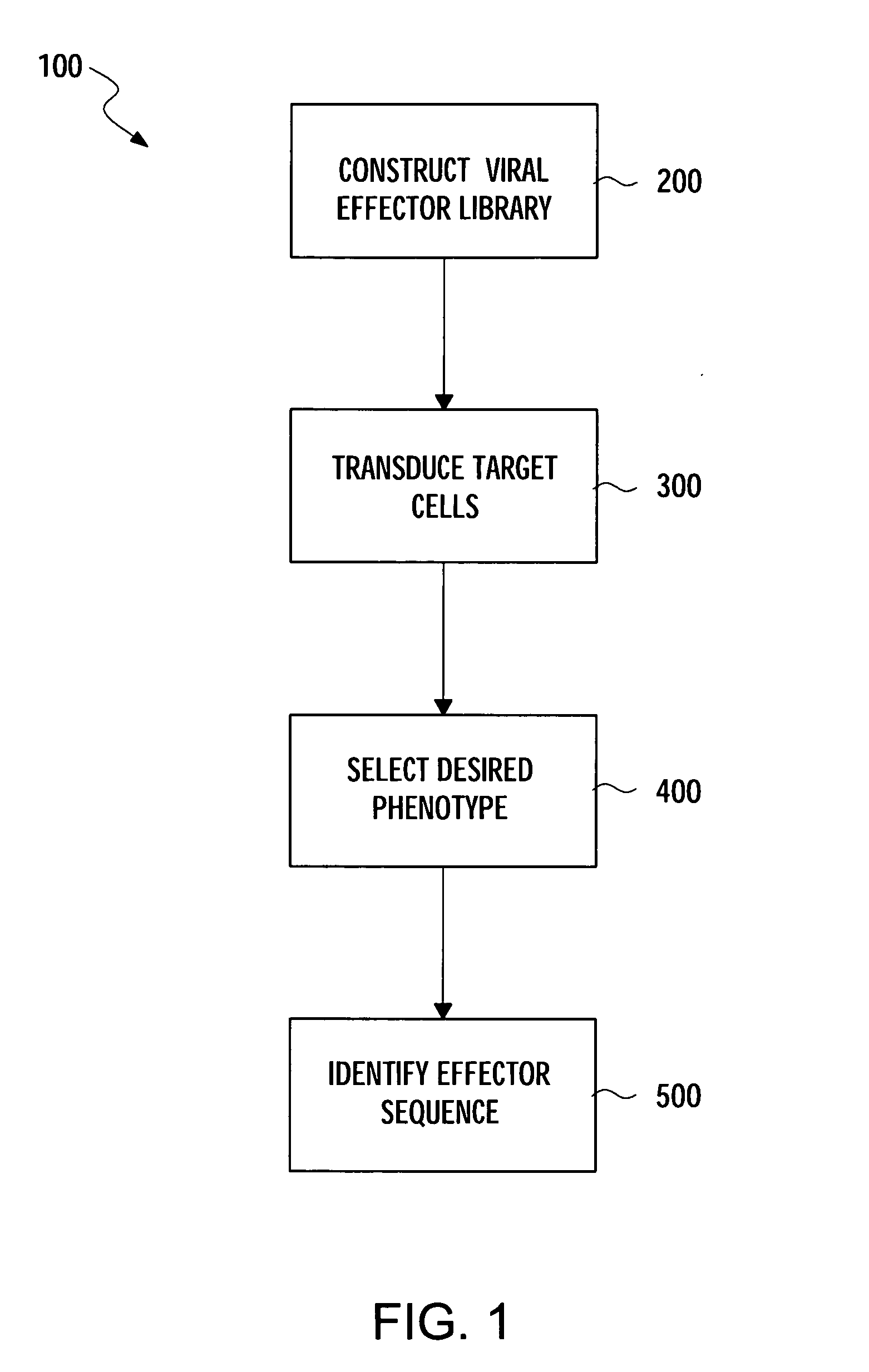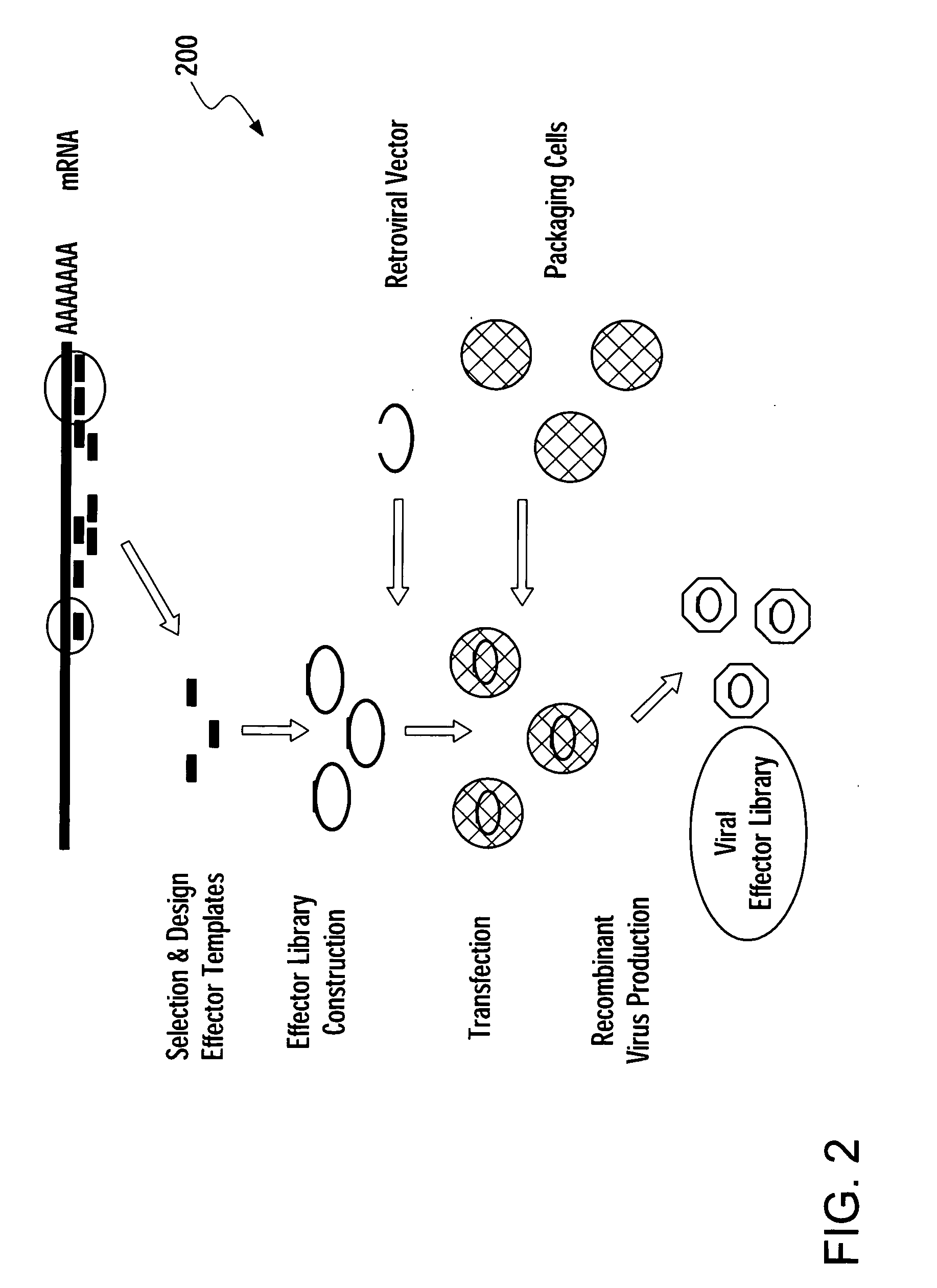Methods for gene function analysis
a gene function and analysis method technology, applied in the field of gene function analysis, can solve the problems of broad application of catalytic rnas, aptamers or intramers, and achieve the effects of reducing the number of bacterial infections
- Summary
- Abstract
- Description
- Claims
- Application Information
AI Technical Summary
Benefits of technology
Problems solved by technology
Method used
Image
Examples
example 1
Development of Lentiviral Vectors for Cloning Effector Libraries.
[0076] In order to develop an efficient siRNA library transduction vector; a pL-reporter lentiviral backbone was used in which the puromycin-resistance gene is controlled by H4 promoter (see FIG. 3). A small polylinker containing Clal, BamHI and EcoRI restriction nuclease sites was introduced into the U3 region of the 3′ LTR. The polylinker can be used to clone single promoter (H1) siRNA expression cassette or double promoter (U6 / H1) siRNA expression cassette.
[0077] In one embodiment, a single promoter H1siRNA expression cassette was assembled from chemically synthesized oligonucleotides and cloned into the Clal-BamHI sites to direct transcription of small hairpin RNAs, which are processed into functional siRNA by cellular enzymes. The resulting single promoter expression cassette pLSLP construct was very similar in design to other retroviral vectors that have been used successfully for cloning and expression of siRN...
example 2
Construction of Effector Libraries in Lentiviral Vectors and Testing Effector Representation in Effector Libraries
[0085] A protocol for the construction of high complexity siRNA libraries in single promoter and double promoter pLSLP vectors was developed, as was a test for the stability of these siRNA libraries by hybridization with the Affymetrix Human Genome Focus Array (Affymetrix Cat. N 900377). The Affymetrix Human Genome Focus Array comprises about 90,000 (25-nucleotide long) oligonucleotide probes for 8,500 unique human transcripts (using about 11 probes / sequence) derived from RefSeq database. Based on genes present in the human Genome Focus Array, 1,500 genes related to cancer were selected for siRNA library construction. Five siRNA template oligos (27-mers) were designed for each of these genes based on selection parameters that have been developed for choosing efficient siRNAs. The 7,500 oligos (5×1,500 genes) were synthesized on the surface of glass slides (custom 7.8K “...
example 3
Development of Lentiviral Transcriptional Reporter Vectors and their us with Eff ctor Constructs.
[0090] A novel HIV-based lentiviral transcriptional reporter vector, pL-p53RE-LacZ-H4-puro, has been developed. This reporter vector was originally designed to screen for chemical compounds that might activate a p53-dependent pathway using induction of beta-galactosidase as a reporter. The lentiviral backbone of the pL-p53RE-LacZ-H4-puro vector was derived from a self-inactivating lentiviral vector pLV-GFP (Pfeifer, et al., PNAS, 99: 2140 (2002)). The pL-p53RE-LacZ-H4-puro vector was engineered to provide high viral titer and to inactivate the promoter in the 5′ LTR following integration into the host genome. Self-inactivating vectors provide more consistent and improved expression due to reduced promoter interference, and self-inactivating lentiviral vectors are safer to work with because they are less likely to form replication-competent retrovirus.
[0091] In order to construct the pL...
PUM
| Property | Measurement | Unit |
|---|---|---|
| fluorescent | aaaaa | aaaaa |
| colorimetric | aaaaa | aaaaa |
| luminescent | aaaaa | aaaaa |
Abstract
Description
Claims
Application Information
 Login to View More
Login to View More - R&D
- Intellectual Property
- Life Sciences
- Materials
- Tech Scout
- Unparalleled Data Quality
- Higher Quality Content
- 60% Fewer Hallucinations
Browse by: Latest US Patents, China's latest patents, Technical Efficacy Thesaurus, Application Domain, Technology Topic, Popular Technical Reports.
© 2025 PatSnap. All rights reserved.Legal|Privacy policy|Modern Slavery Act Transparency Statement|Sitemap|About US| Contact US: help@patsnap.com



